1lumen selects and reviews products personally. We may earn affiliate commissions through our links, which help support our testing.
Manker F14 review
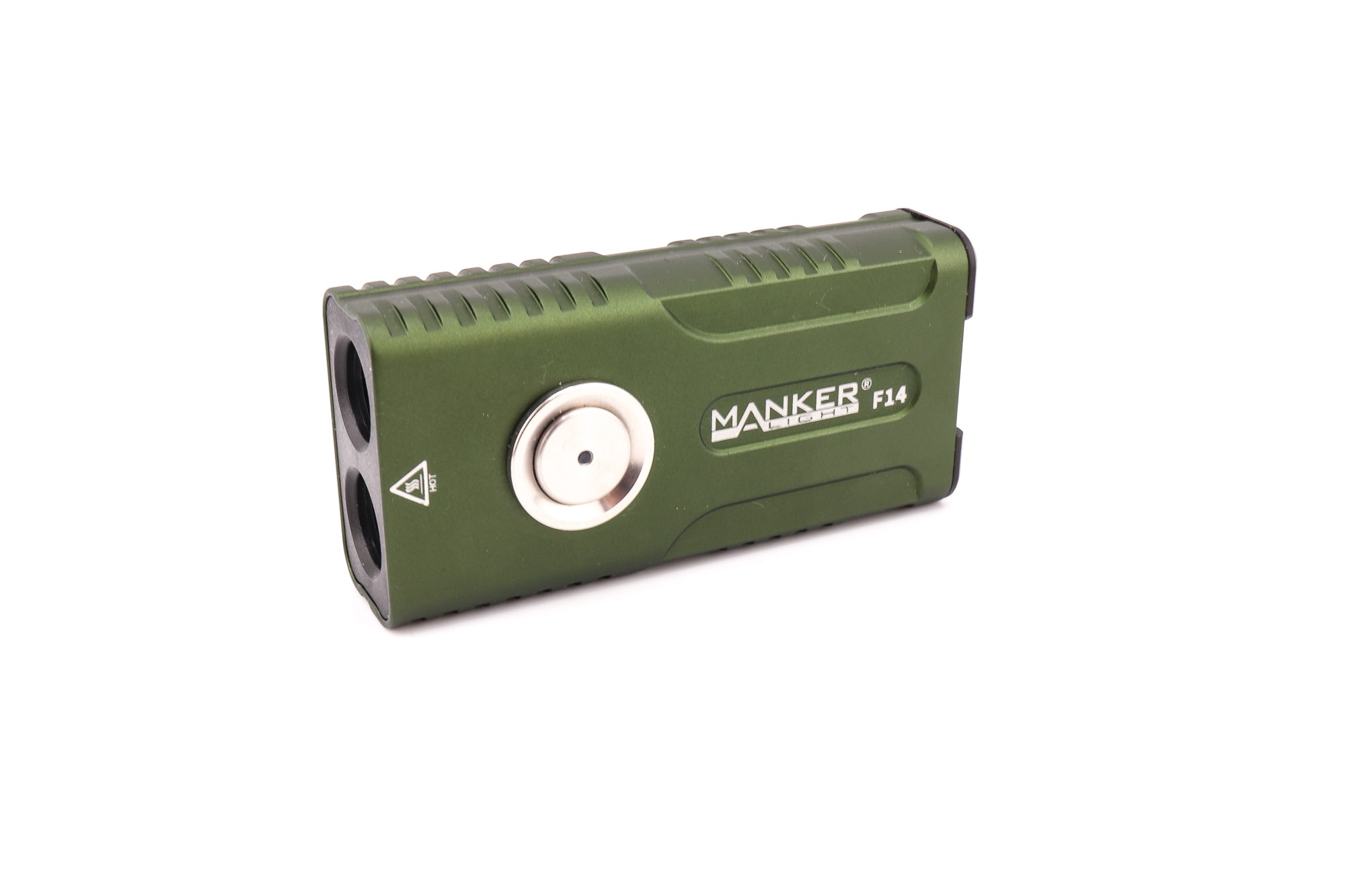
Manker F14 specifications
| Brand & Model | Manker F14 |
|---|---|
| Flashlight category | EDC flashlight / Pocket flashlight |
| LED | Samsung LH351D + Osram NM1 |
| Max. output | 1250 lumens |
| Max. beam distance | 268 metres |
| Max. beam intensity | 17,956 cd |
| Battery config. | In-built 1800mAh LiPo |
| Onboard charging | Yes |
| Main modes | 10 |
| Blinkies | Strobe |
| Waterproof | IP65 |
| Review publication date | March 2024 |
Review intro:
Manker is a brand I’m very familiar with. I have a good number of their lights in my collection and as a rule they have always been keen to provide lights that offer something for the enthusiast end of the market, not just as a tool or a utility.
The F14 looks very exciting with a completely different design to a regular LED torch
What’s in the package
The F14 is available in black or army green. I have the green one on test, although functionally they are the same. The F14 comes in a nice looking retail style box. In the box you will find:
- The F14 flashlight
- Lanyard wrist strap
- USB-C cable
- USB-A to C converter
- instruction manual
There is also a pocket clip that is pre-fitted to the body of the F14.
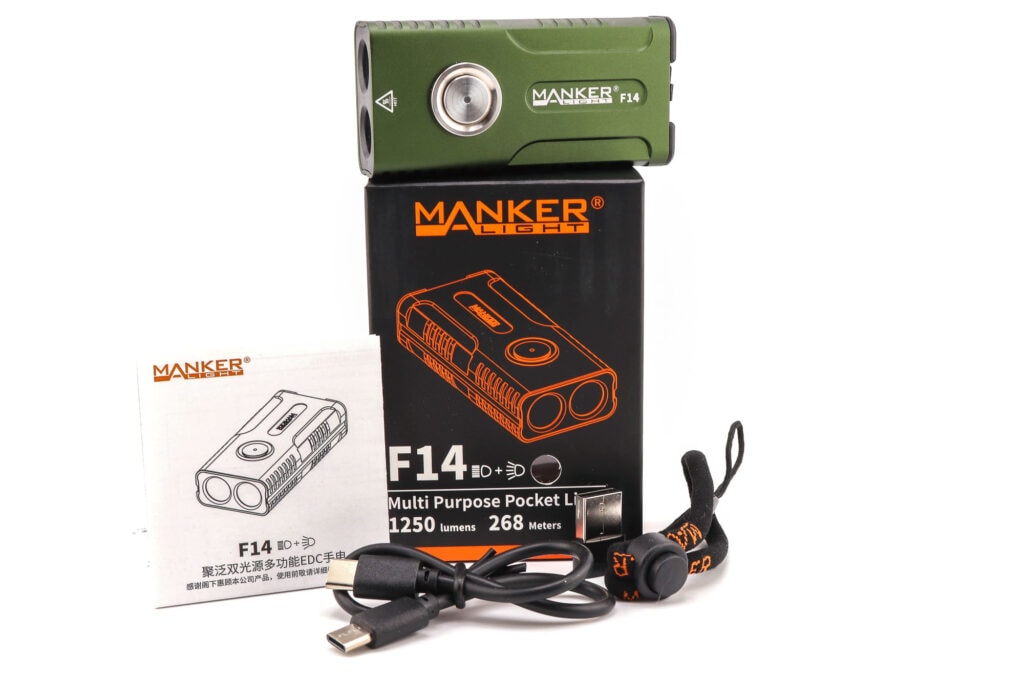
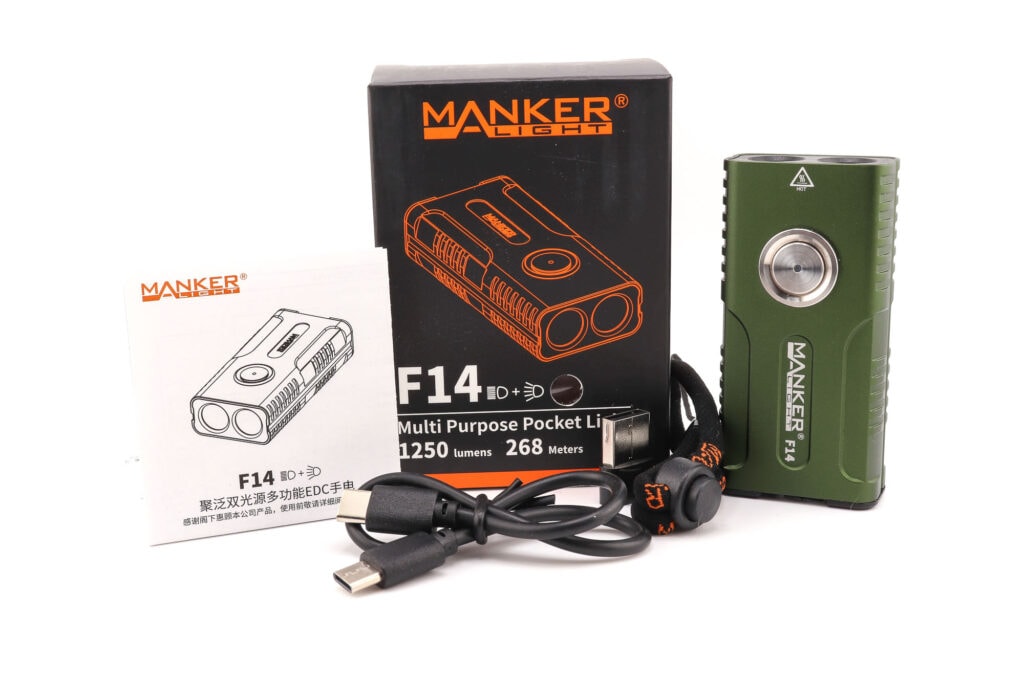
Flashlight in use, Build Quality, and Warranty
Overall the F14 seems well put together, it feels solid, is nicely finished and looks great. But the switch is pretty terrible. I don’t know if this is true of every example or just the one I’m testing. It makes a creaking sound and just isn’t all that pleasant to use, requiring an overly firm press, making the complex UI even more difficult to use.
Using the F14 I’m left a little puzzled. As I said earlier, I was very excited to sample a light of this format. But the reality is, it is rather horrid to hold. It is too angular and uncomfortable in the hand. The pocket clip is good, but makes the grip even more uncomfortable and it just feels bulky and uncomfortable in the pocket.
On the flip side, it tail-stands very well and has great anti-roll properties. There is also a decent magnet on the tail end and you can use the F14 as a mini power bank.
In terms of use, I found it was just too uncomfortable to use as an EDC in my pocket. Although it probably would make for a reasonable bedside light, that will heavily resist rolling off the bedside table.
Due to having a built in battery and an electronic switch, there is a constant power drain, so it probably doesn’t serve well as an emergency or backup light, unless you are prepared to check the charge level every once in a while and keep it topped up.
While having a dual beam is a novel idea. It works less well in practice and this light is screaming out for a dual button control. More on this in the User Interface section.
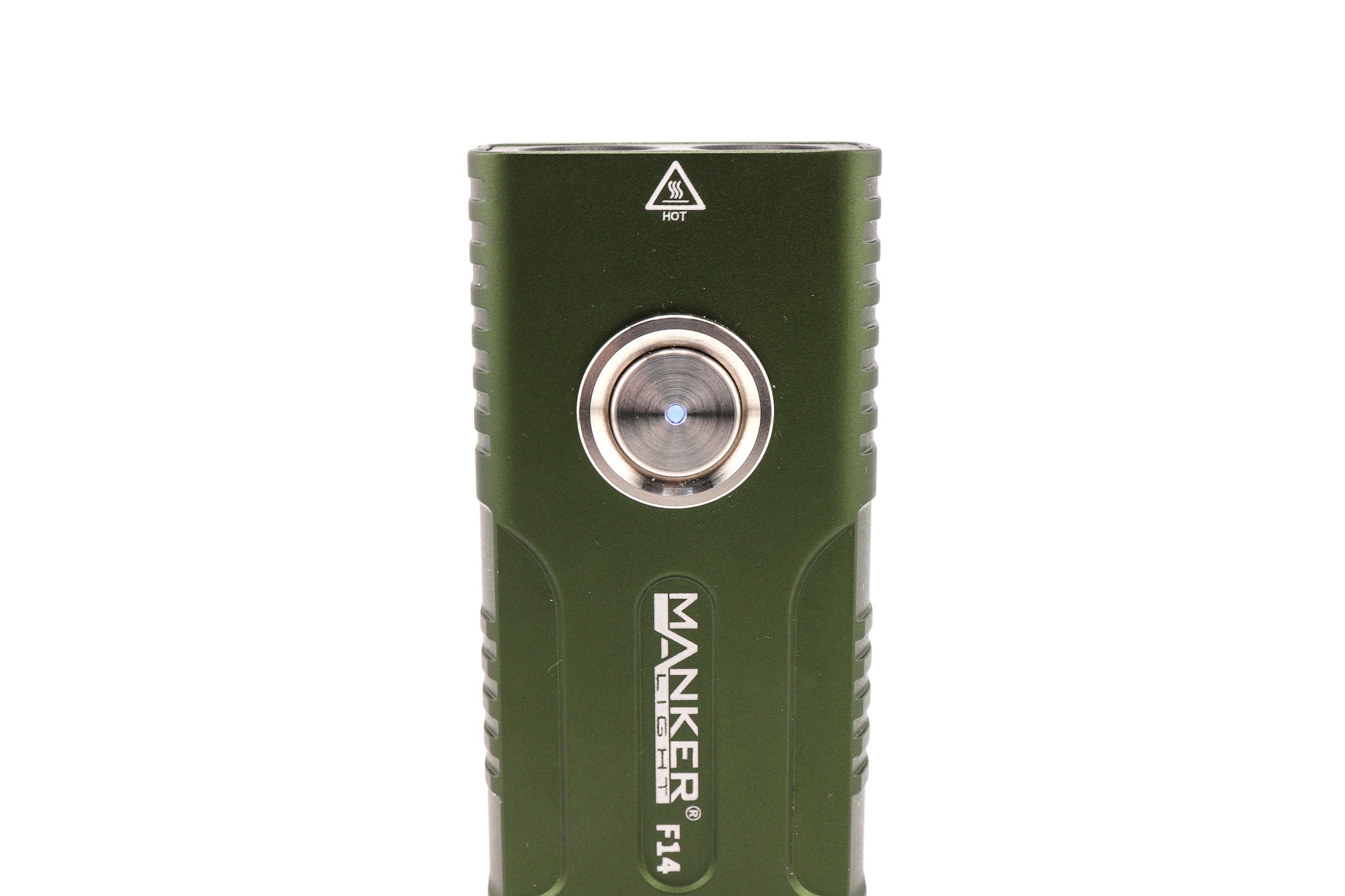
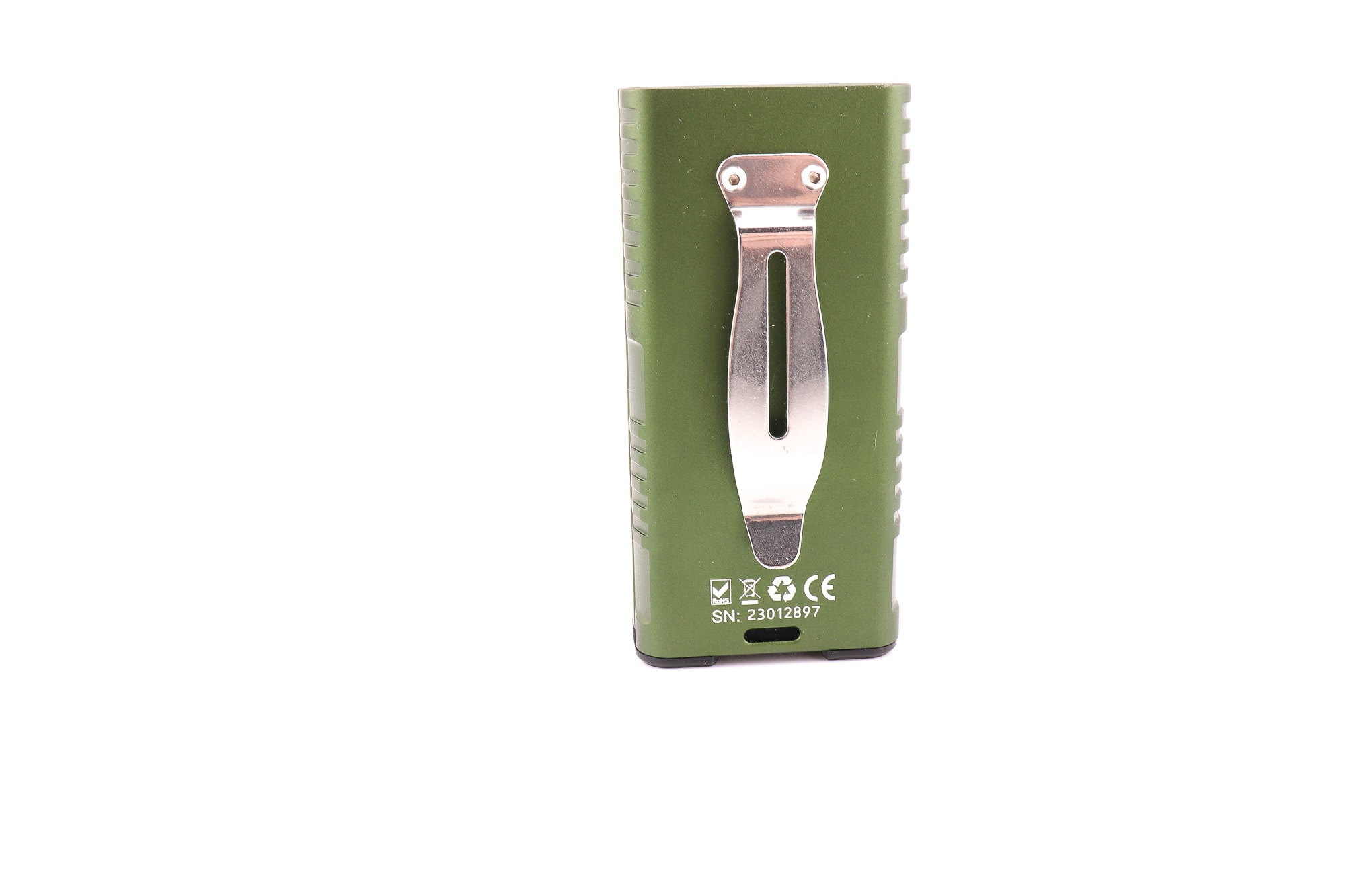
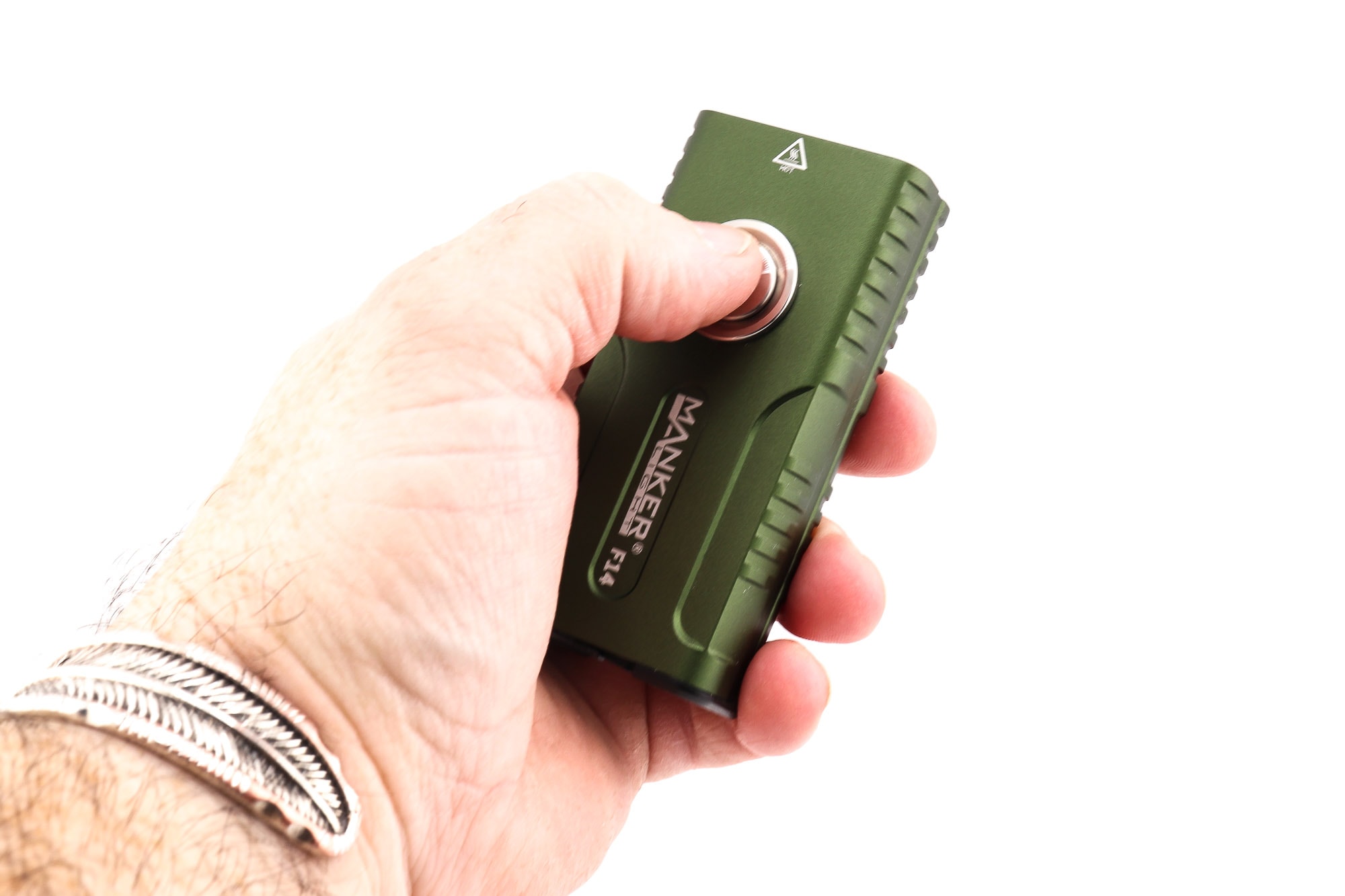
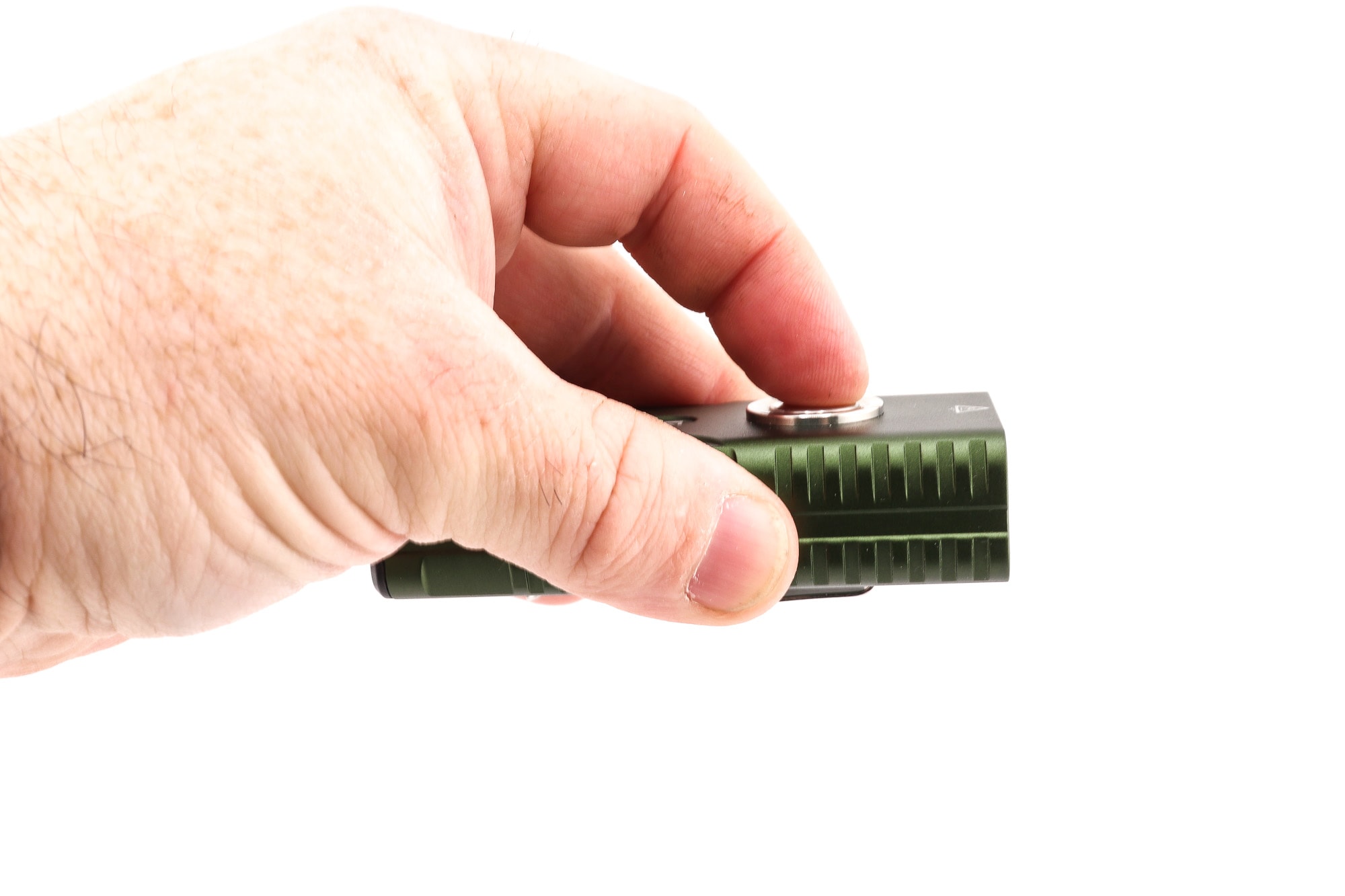
LED, Lens, Bezel, Beam, and Reflector
The F14 doesn’t have a traditional bezel as such, but it does have a textured plastic front. The Osram LED has a smooth reflector. while the Samsung has an orange peel one.
The reflectors appear to be the same size and depth for both LEDs, although I think this hampers performance a bit. The floody Samsung LED would probably be better served by a much more shallow reflector or even a TIR optic. The reflector gives quite a narrow beam, which just doesn’t suit a floody beam the best and gives quite a narrow field of view. The spot beam on the other hand with the Osram LED seems to suit this sized reflector more so.
It’ll never be an ultimate thrower, but the Osram’s beam is pretty good for some distance, but is generally more of a general purpose sort of beam.
With the vastly different Kelvin ratings and colours of the beams, it is quite a shock to the system to go from one to the other. They are at either end of the spectrum pretty much and really do pose a conflict. The blended beam is quite nice, but not practical to use, partly due to how the UI works, but also heat and runtimes.
I see the concept Manker where going for, but if I’m honest I find the light a bit of a challenge to use due to its polar opposites in beams.
Spectral measurements:
I used an Opple Lightmaster Pro to measure the flashlight at 3 metres distance.
| Mode: | CCT: | CRI Ra: | duv |
|---|---|---|---|
| Turbo (Osram NM1) | 6324K | 68.7 | -0.0003 |
| Turbo (Samsung LH351D) | 3943K | 92.1 | 0.0039 |
| Turbo (mixed LED) | 5784K | 73.5 | -0.0012 |
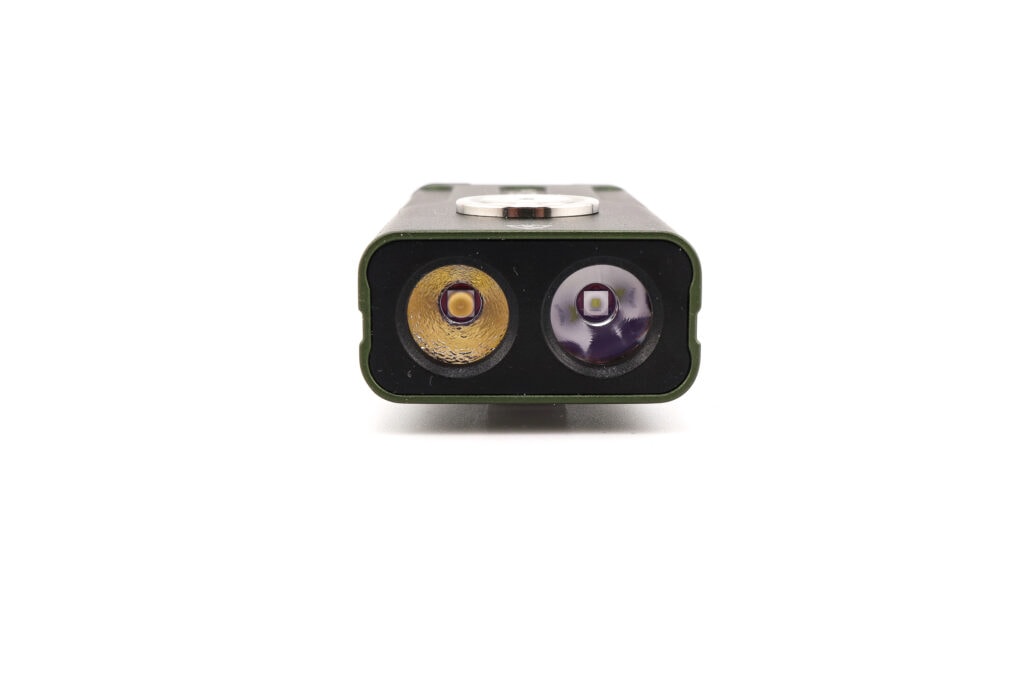
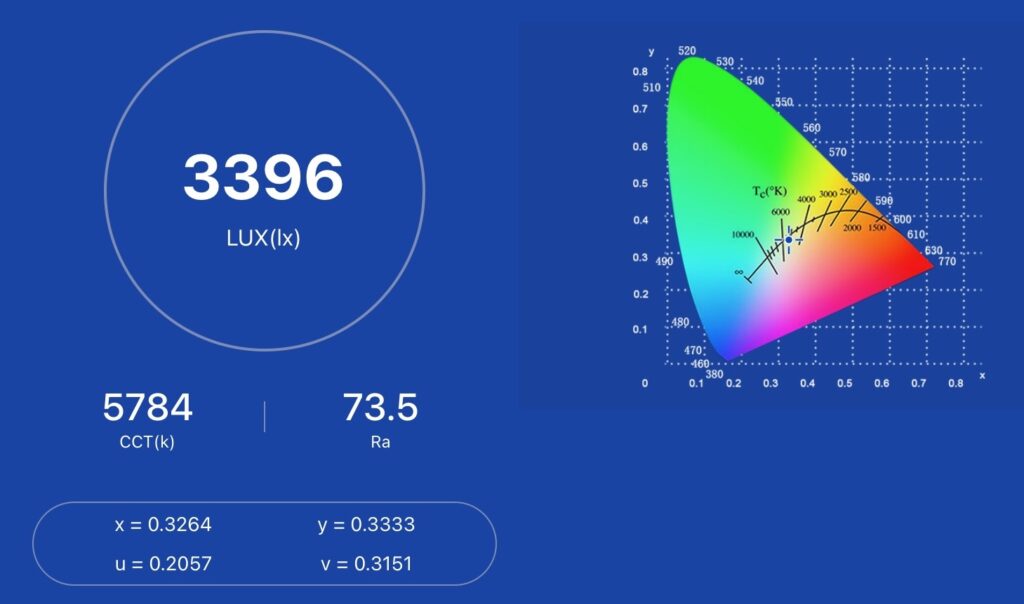
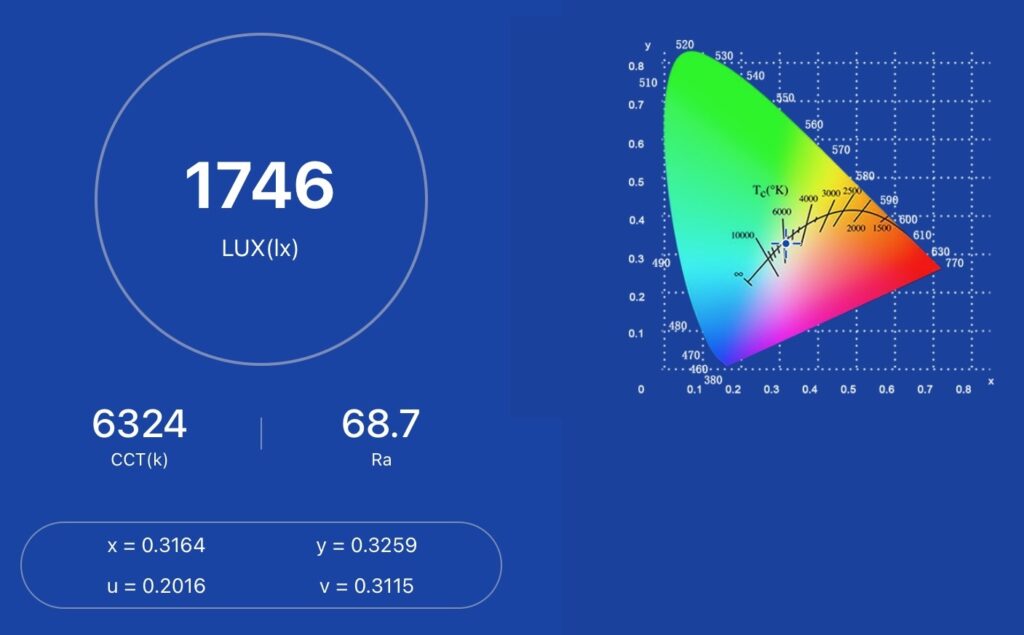
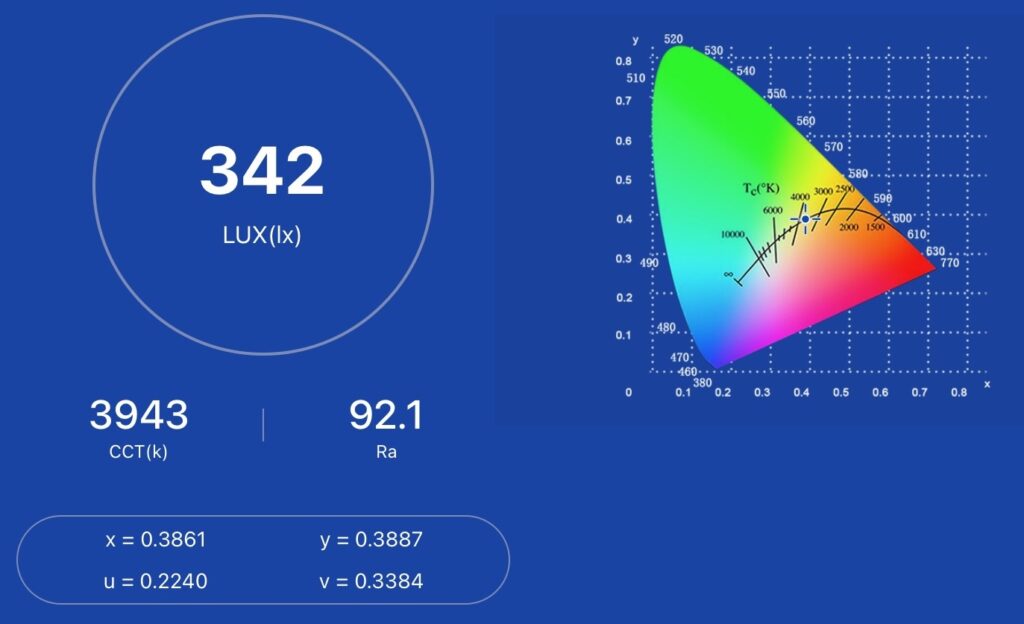
Dimensions and its competition
Dimensions:
| Manker F14 | Millimetres | Inches |
|---|---|---|
| Length | 81.5mm | 3.21in |
| Width | 39mm | 1.53in |
| Height | 20mm | 0.78in |
Dimensions are rounded to the nearest millimetre and the nearest tenth of an Inch.
Weight:
| Manker F14 | Weight in grams | Weight in oz |
|---|---|---|
| With battery | 110g | 3.88oz |
Weight is rounded to the nearest gram and tenth of an Oz.
Flashlight size comparison with its competition:
Group 1: Convoy T3, Manker F14, Manker MC01
Group 2: Mini Maglite AAA. Manker F14, Speras E21
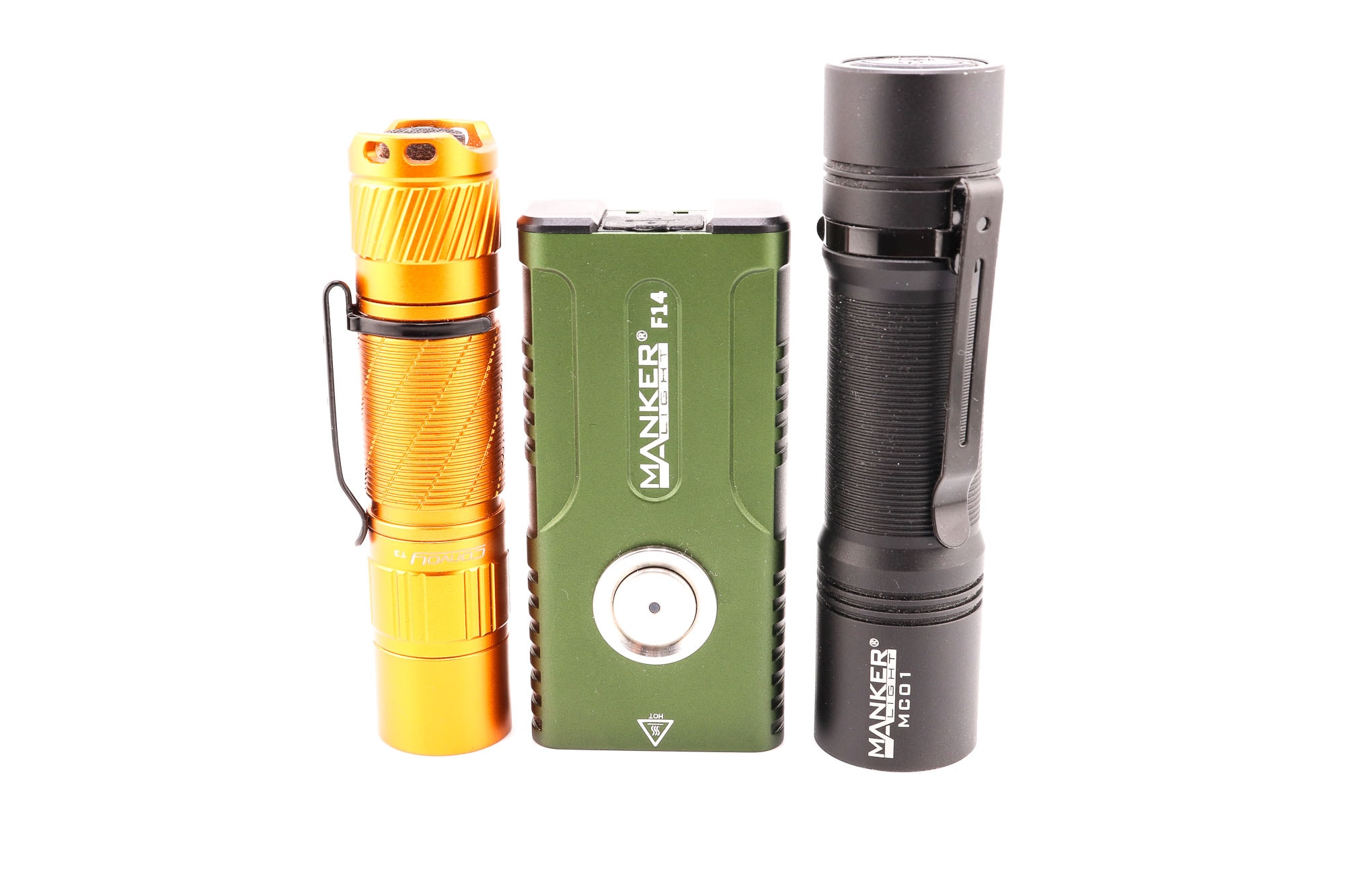

Manker F14 UI: User Interface and Driver
Available modes:
- Far too many….. 11 I think, but there could be more!
Available blinky modes:
- Yes, strobe.
From OFF:
- Press and hold: Moonlight
- Single click: General Mode
- Double click: Turbo Mode
- 3 fast clicks: Turbo Mode (the other LED)
- 4 fast clicks: Dual LED Turbo Mode
- 5 fast clicks: Lockout
From ON:
- Press and hold: Cycle from Low to High to Low to High
- 1 click: Off
- Double click: Turbo or Strobe if you are in Moonlight
- 3 fast clicks: Switch LED
- 4 fast clicks: Dual LED Mode
Mode memory:
- Yes, but it is confusing as it may remember a mode or an LED or both. But no way really to know what it has or hasn’t remembered.
Shortcuts:
- To Moonlight: Press and Hold from Off
- To Turbo: Double click from On and Off, and triple click for Turbo mode with the other LED
- To Strobe: No, only accessible from Moonlight mode
Low voltage warning/protection:
- Yes and switch LED as battery meter
Strobe/blinkies
- From ON: Double click: Turbo or Strobe if you are in Moonlight
Lock-out mode:
- Yes. 5 fast clicks from Off
PWM
- None that I can detect.
Additional/summary info on the UI:
- Oh dear, where to start with this one. Let me say, I truly truly hate the UI on the F14. It is confusing, way too complex and somehow also manages to be rather restrictive all at the same time.
- A quote from the Manker website; “New friendly & easy User Interface”. I have no idea what they are drinking, but you clearly need a lot of it to get to grips with the UI.
- Ok, let’s start at the basics. The switch…. Is it not very nice, it is heavy, very heavy to depress, has quite a lot of edge/side movement and makes a creaking sound. The more you use it the more you get used to it. But to perform something like a rapid 5 click action, you really do need to take a deep breath and psych yourself up ready for it. A nicer switch would help, but only so far. The design of the UI is, well let’s say interesting. Confusing would also be a good term too.
- For instance you can only have Moonlight on the Samsung LED, there is no option to use the Osram LED for an ultra low output mode, which is a shame as a throwy low output beam can be very handy to preserve your night vision. You can also only have Strobe on the Osram LED. And to get to strobe you first have to activate Moonlight, which is only available when the light is off….. So if you are using the light in any other output mode and need to use the strobe. Be prepared first switch the light off, then click and hold for Moonlight, then double click for Strobe. Wow, even writing it down gives me a headache!
- Other issues with the UI is the weird memory, as it’ll also try and remember the LED you used last and output mode. Although I’d say this means that 95% of the time it’ll then be in the wrong mode when you turn it back on. But when you have all these different combos it just adds to the confusion as you don’t really know what mode you’ll get apart from Moonlight or Turbo. But moonlight only allows strobe or off as your only options and even Turbo is a gamble on which LED it’ll be. If you are using it all the time to try and recall the complex interactions maybe this is workable, but I found it way too much effort and hardwork to keep on top of.
- To top it all off, the mode diagram is very confusingly written and the key to the diagram is backwards from all the many arrows on the diagram.
- My personal view is, the F14 should have been a dual switch light. Two smaller switches next to each other, allowing individual control over each LED in a more normal fashion, would have been an utter winner from a UI stand-point.
Manker F14 Charging and batteries
The F14 comes equipped with an inbuilt LiPo of 1800mAh. There is also USB-C charging, which uses the small LEd on the switch to indicate charge state.
While LiPo’s can easily power an LED flashlight, I do know LiPos tend to have a shelf life and can puff up and eventually expire when used in things like RC cars or planes. This makes me wonder how batteries such these will last in a sealed LED where you cannot easily or practically replace the battery should it fail. I guess time will tell, but for now I still chalk it up as a potential concern.
| Charge type | Fits | No fit | Charge time |
|---|---|---|---|
| Flashlight with onboard USB-C | In built | n/a | 2-3hrs |
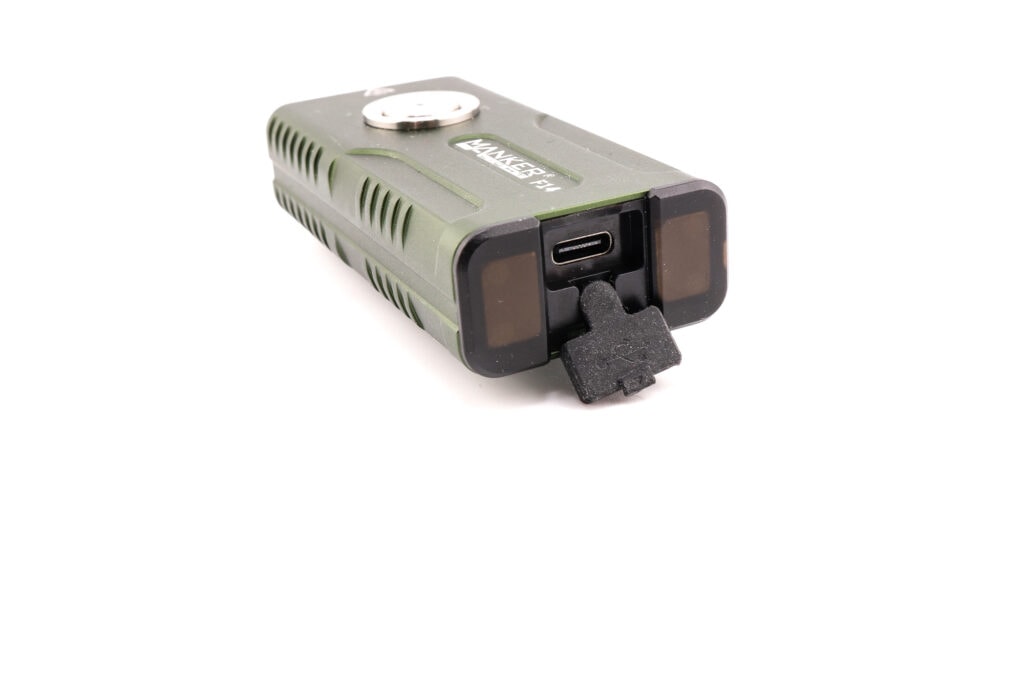
Performance test
Lumen measurements
How Lumens are Measured: Understanding ANSI FL1 Standards How Lumens are Measured: Understanding ANSI FL1 Standards: The ANSI FL1 standards specify that output in lumens should be measured 30 seconds after turning on, as this is the standardized time for measuring brightness according to the industry standard. This is why we focus on this part in our measurements. The ANSI FL1 standards require an ambient temperature of 22 ± 3°C. We record the ambient the ambient temperature to identify potential reasons for any observed discrepancies.Samsung LH351D
| Mode | Specified | Turn on | 30 sec. | 10 min. |
|---|---|---|---|---|
| Moon | 1 lm | 1 | 1 | 1 |
| Low | 140 lm | 158 | 158 lm | – |
| High | 320-240-7 lm | 341 | 335 lm | 266 |
| Turbo | 750-240-7 lm | 767 | 660 lm | 264 |
Osram NM1
| Mode | Specified | Turn on | 30 sec. | 10 min. |
|---|---|---|---|---|
| Low | 70 lm | 62 | 62 lm | – |
| High | 260-220-7 lm | 243 | 237 lm | 188 |
| Turbo | 520-220-7 lm | 325 | 316 lm | 185 |
Samsung LH351D + Osram NM1
| Mode | Amps at start | Specified | Turn on | 30 sec. | 10 min. |
|---|---|---|---|---|---|
| Turbo Turbo | Unable to test | 1250-364-17 | 1118 | 949 | 346 |
Ambient temperature during testing:
- 12°C
Manker F14 Battery Life: Runtime graphs
How Runtimes are Measured: Understanding ANSI FL1 Standards About ANSI FL1 runtime standards: The runtime is measured until the light drops to 10% of its initial output (30 seconds after turning on). This does not mean that the flashlight is not usable anymore. The last column shows how long the light actually works till it shuts off. If there is a + symbol, it means that the test was stopped at that particular point, but the light was actually still running. This happens on certain occasions, with certain drivers, firmware, or batteries.Samsung LH351D
| Mode | Specified | Runtime (ANSI FL1) | Time till shut off |
|---|---|---|---|
| Moon | 248h | Not tested | Not tested |
| Low | 5h 39min | Not tested | Not tested |
| High | 1m 30sec+2h 24min+1h | 1h 43min | 2h 36min |
| Turbo | 1min 30sec+2h+1h | 1h 37min | 2h 44min |
Osram NM1
| Mode | Specified | Runtime (ANSI FL1) | Time till shut off |
|---|---|---|---|
| Low | 6h 40min | Not tested | Not tested |
| High | 1min+2h 5min+1h | 2h 34min | 4h 10min |
| Turbo | 1min+1h 41min+1h | 2h 31min | 4h 3mins |
Samsung LH351D + Osram NM1
| Mode | Specified | Runtime (ANSI FL1) | Time till shut off |
|---|---|---|---|
| Turbo Turbo | 1min+59min+40min | 1h 15min | 1h 56min |
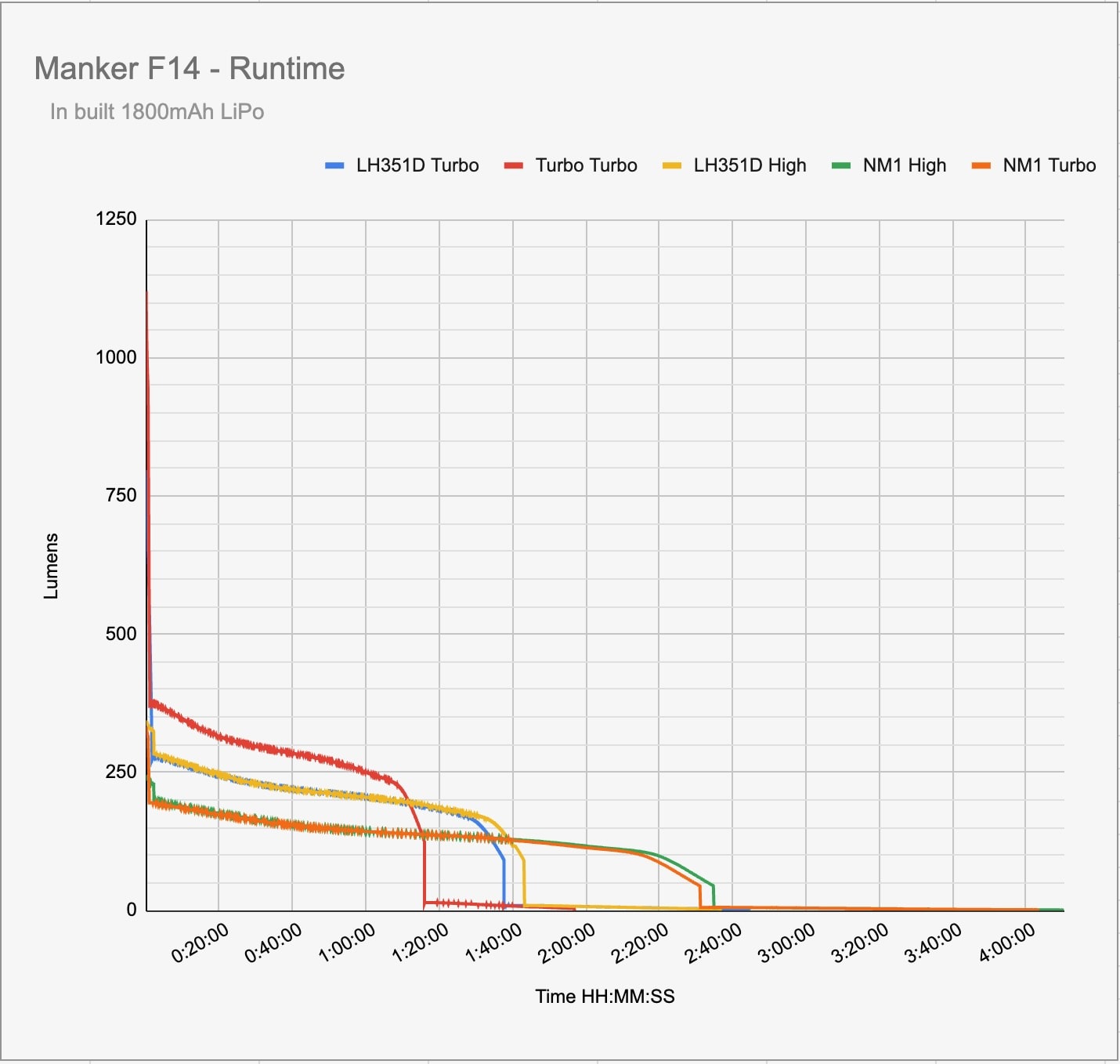
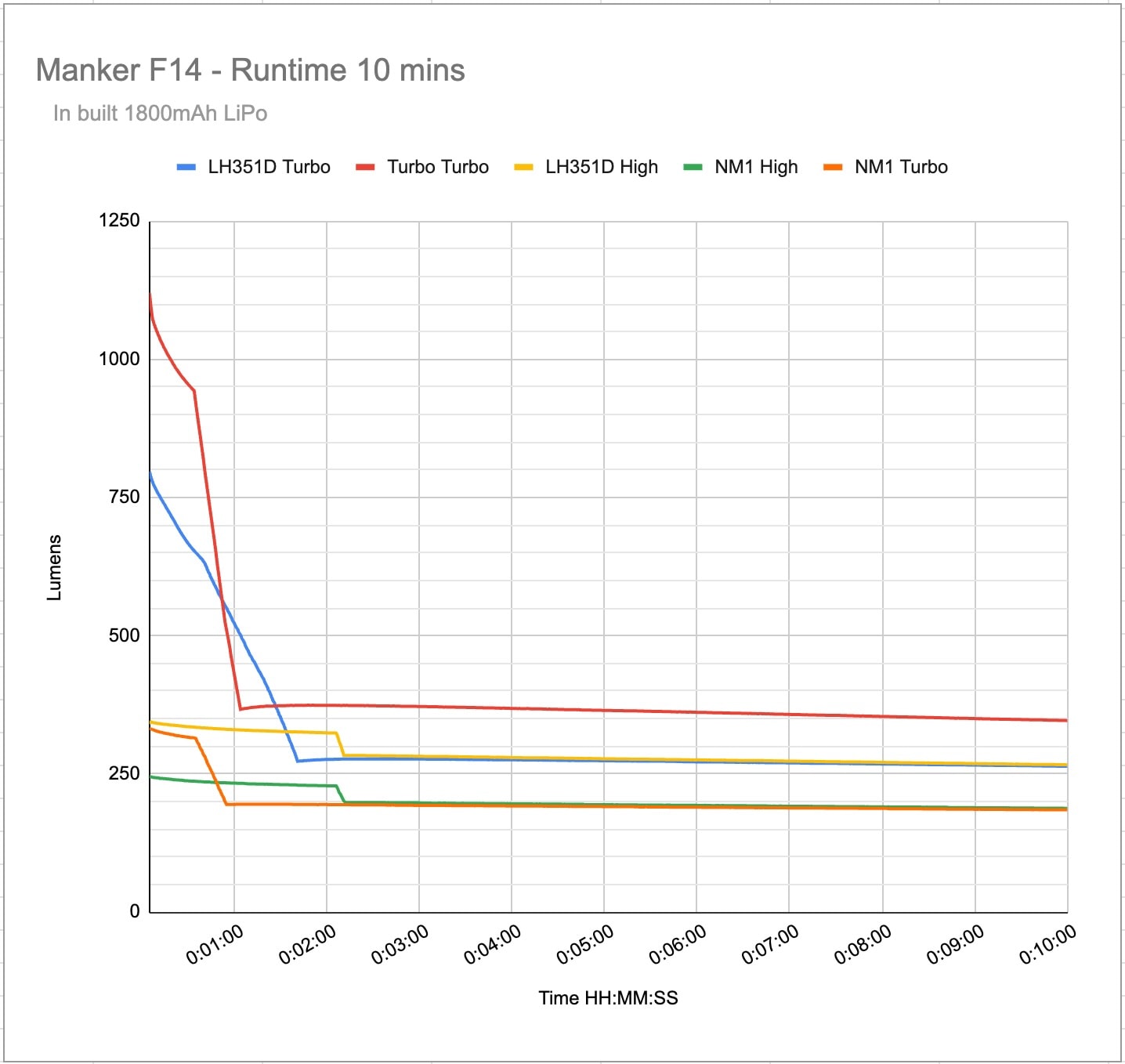
Peak beam intensity and beam distance measurements
About Peak beam intensity: Understanding ANSI FL1 Standards About peak beam intensity The calculated value of distance in meters at which the flashlight produces a light intensity of 0.25 lux. (0.25 lux is about the brightness of a full moon shining on an object). This means that the intensity has decreased so much, it becomes difficult to see darker objects, or objects that don’t reflect light. The columns ‘Meters’ and ‘Yards’ use rounded numbers.Samsung LH351D
| Mode | Specified | Candela measured | Meters | Yards |
|---|---|---|---|---|
| Low | Not claimed | 724cd | 54m | 59yd |
| High | Not claimed | 1654cd | 81m | 89yd |
| Turbo | Not claimed | 3079cd | 111m | 121yd |
Osram NM1
| Mode | Specified | Candela measured | Meters | Yards |
|---|---|---|---|---|
| Low | Not claimed | 2265cd | 95m | 104yd |
| High | Not claimed | 8504cd | 184m | 201yd |
| Turbo | 14,000cd / 240m | 9978cd | 200m | 219yd |
Samsung LH351D + Osram NM1
| Mode | Specified | Candela measured | Meters | Yards |
|---|---|---|---|---|
| Turbo Turbo | 17,956cd / 268m | 13,402cd | 229m | 250yd |
Ambient temperature:
- 20°C
Beamshots
Camera: Canon EOS 200D, Canon 18-55mm EFS IS at 18mm, ¼ sec, F4.5, ISO1600, WB 5200k
To take the photos the camera and torch are both mounted to a tripod using a timer on the shutter. Beam shots are taken at two different distances.
Distance: 5m to the tree on the left and 11m to the compost heap
- Manker F14 Samsung
- Manker F14 Osram
- Manker F14 dual LED
- Convoy T3 Nichia 519A
- Manker MC01 Samsung LH351D
Please note that the following beamshots are mainly intended to showcase the beam pattern and beam quality, rather than overall performance. These images are typically taken directly after activation, and in different seasons or weather conditions, and therefore do not fully represent its overall performance. For accurate performance metrics, such as output, beam distance, and runtimes, you need to look at the performance section of this review.


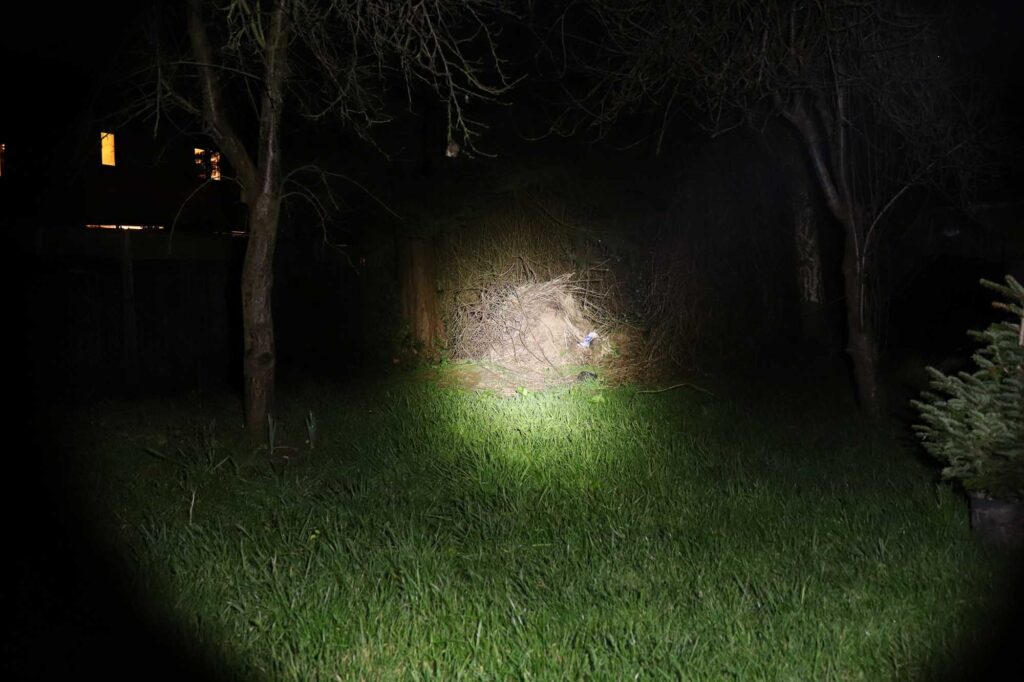
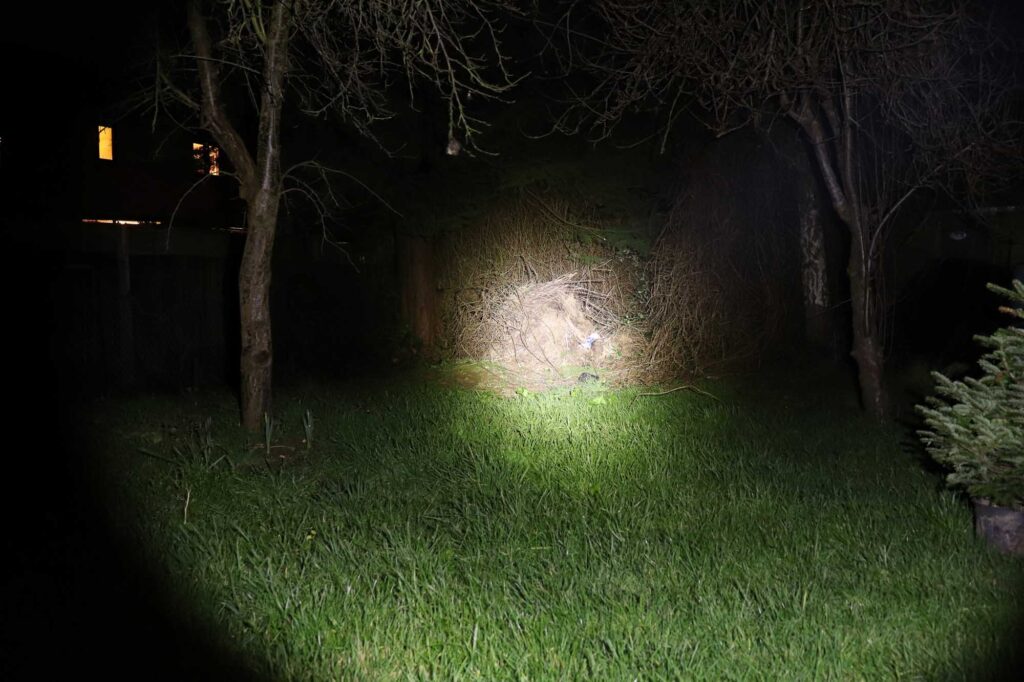

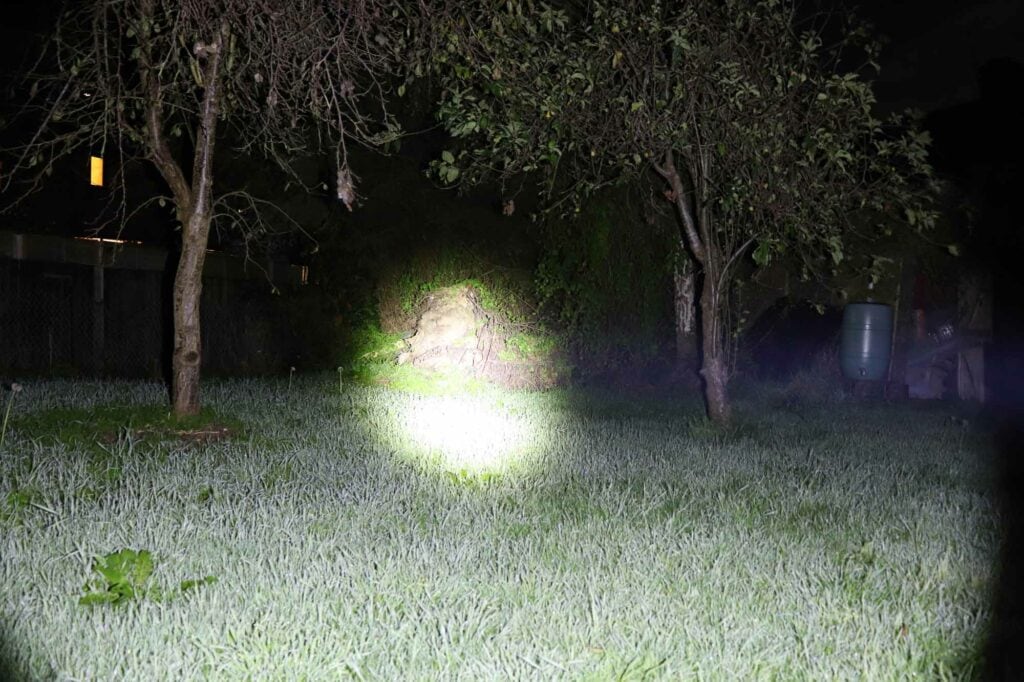

Beamshots of the following flashlights compared @ 100m:
- Manker F14 Samsung
- Manker F14 Osram
- Manker F14 dual LED
- Convoy S2+ Osram W1
- Spearas E21 SST-40
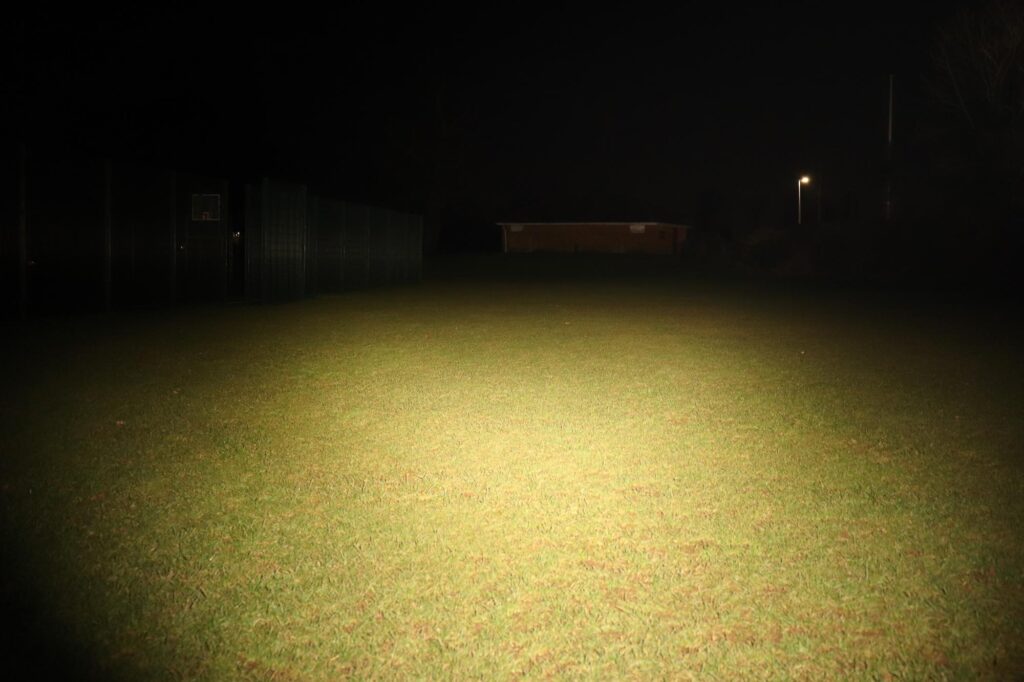
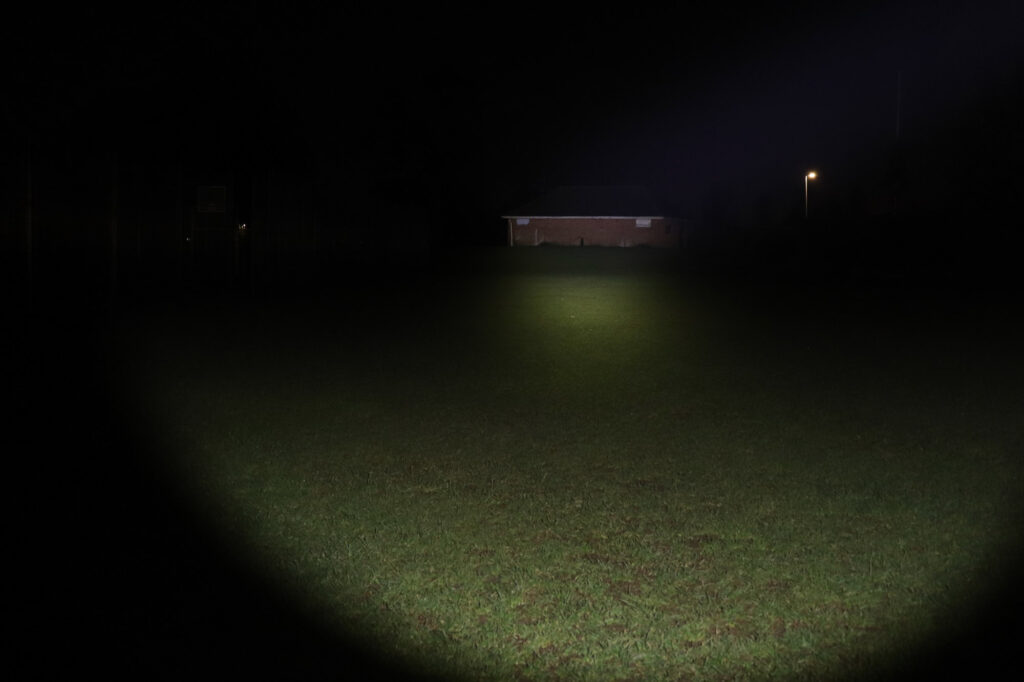
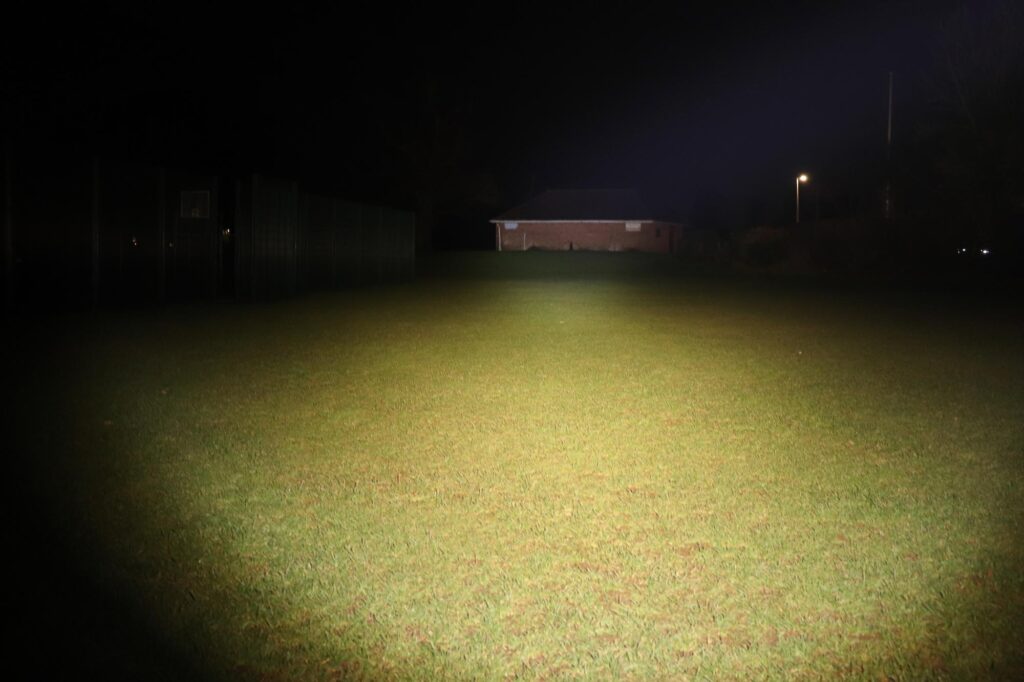
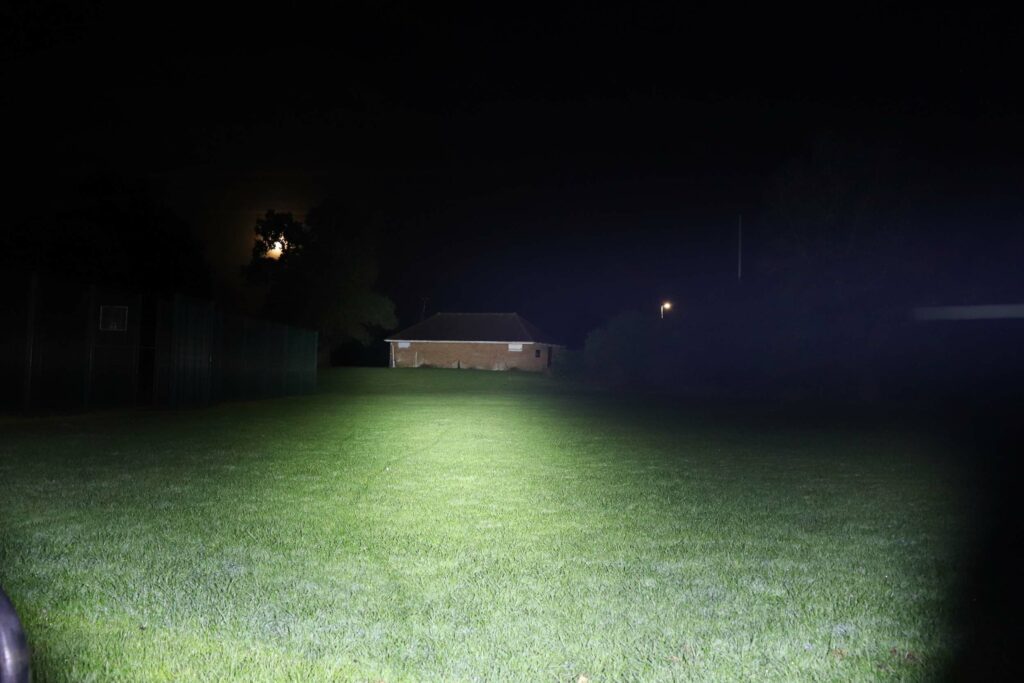
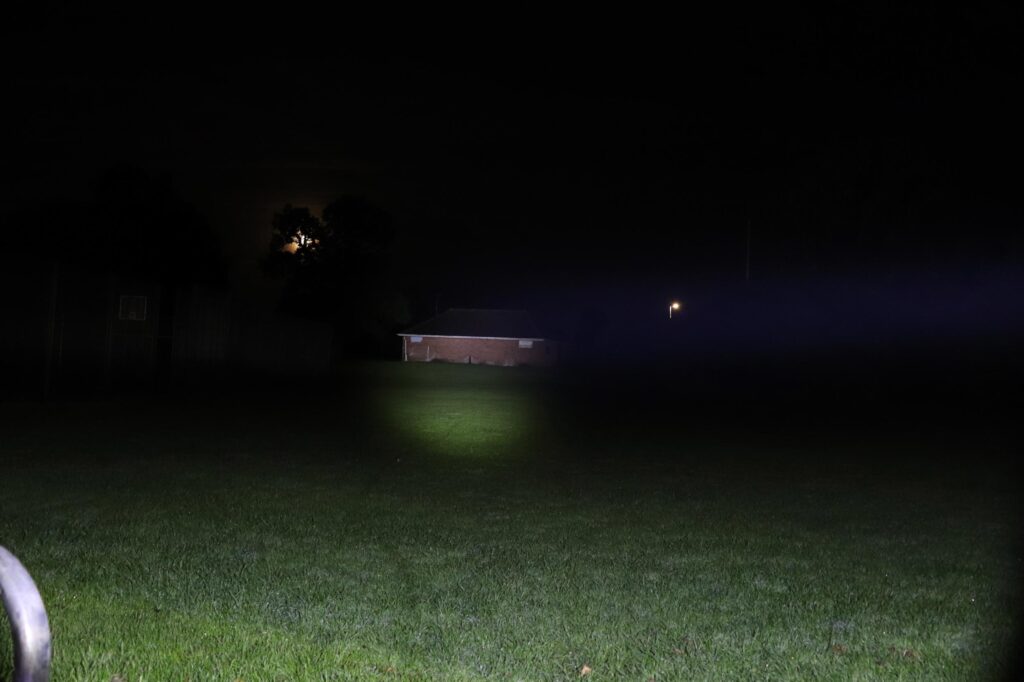
Disclaimer: This flashlight was sent to us for review at no cost by FlashlightGo. We have not been paid to review, nor have we been holding back on problems or defects.
Final Verdict
Pros
- Nicely built overall
- Green coloured body
- Interesting design and unusual
- Anti roll properties
- Powerbank feature
- Magnet
Cons
- User Interface
- Side switch
- Non pocket friendly shape
- Not that nice in the hand
- Split personality from one extreme to the other
Explanation on star ratings:
1: Avoid: a match would be a better choice – 2: Poor: significant defect or issues; almost unusable – 3: Average: some defects or issues; but still usable 4: Good: recommended (minor issues) – 5: Great: highly recommended

2 stars: ★★
While our star rating provides a reliable indicator, we encourage you to read the full review to make an informed decision based on your own needs and preferences.
To be honest I’m all over the show with the F14, on the one hand it looks cool as heck, is a very unique design and individually the LEDs work quite well. But the extreme split personality and frankly shocking user interface bring it all crashing back down. And then finding it unpleasant in the hand and hard (read uncomfortable) to EDC, it leaves me with quite a dilemma.
Part of me says give it 5 Stars, the other says is it even worth a single Star?
I do confess to liking gadgets and cool interesting things and while I find LED torches a huge fascination and hobby, I do ultimately like good design and for items to serve a practical purpose. The F14’s flaws are just too numerous and too serious to take it seriously, thus it earns a rather lowly 2 Stars overall.
Buy your Manker F14 here
Get 10% off all flashlights at FlashlightGo with our exclusive discount coupon: 1lumen
1lumen selects and reviews products personally. We may earn affiliate commissions through our links, which help support our testing.